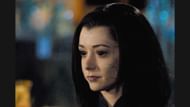Buffy the Vampire Slayer is an American supernatural drama created by Joss Whedon, based on his 1992 film of the same name.
The series follows Buffy Summers (Sarah Michelle Gellar), a young woman chosen to fight vampires and demons. Guided by her Watcher, Rupert Giles, and her friends, the “Scoobies,” she balances teenage life with her destiny in Sunnydale, a town built atop a Hellmouth that attracts evil.
Buffy the Vampire Slayer and Star Trek might seem unrelated, but several Buffy episodes subtly draw from Star Trek’s classic themes of identity and consciousness.
From dreamlike journeys to moral quandaries, these stories show how sci-fi and the supernatural overlap. Here are seven Buffy episodes you probably didn’t know were inspired by Star Trek.
Disclaimer: The following list is ranked in no particular order, and the opinions expressed belong solely to the author.
1) Buffy confronts her perception of reality
 A still from Buffy the Vampire Slayer (Image via Instagram/@buffytvs)
A still from Buffy the Vampire Slayer (Image via Instagram/@buffytvs)In Normal Again, Buffy finds herself in a psychiatric institution, being told that her existence as the Slayer is nothing but a fabrication of her mind. The episode turns her world upside down, leaving viewers to wonder if Buffy truly is a chosen warrior or simply delusional.
A similar disorientation drives Star Trek: The Next Generation’s Frame of Mind, where Riker slips between overlapping realities, unsure if he is performing in a play, trapped in an asylum, or still aboard the Enterprise.
Both stories blur illusion and truth, pulling viewers into the same confusion as their heroes. Though Buffy and Riker return to familiar worlds, a lingering unease remains, a reminder of how fragile identity becomes when reality begins to crack.
2) Primitive desires and the splintered self
 The cast of Buffy the Vampire Slayer (Image via Instagram/@buffytvs)
The cast of Buffy the Vampire Slayer (Image via Instagram/@buffytvs)In The Pack, Xander and several of his peers fall under the influence of ancient hyena spirits, driving them to bully others and even commit horrifying acts, including the death of their principal.
Buffy must confront the savage impulses overtaking her friends, while Xander later faces the remorse of his actions under possession. The story mirrors Star Trek: The Original Series’ The Enemy Within, where Captain Kirk is split into two halves, one gentle, the other ruthless.
Both explore the chaos of losing control to primal instincts and the painful truth that understanding oneself means facing inner darkness. Each story looks beyond external monsters to the fragile balance of instinct and identity within.
3) When nightmares take form
 A still from Buffy the Vampire Slayer (Image via Instagram/@buffytvs)
A still from Buffy the Vampire Slayer (Image via Instagram/@buffytvs)In Nightmares, the boundaries between fear and reality collapse as the Sunnydale gang begins to live out their anxieties. Xander finds himself humiliated before his classmates, Giles loses his ability to read, and Buffy faces the horrifying transformation into a vampire.
A similar unraveling unfolds in Star Trek: The Next Generation’s Where No One Has Gone Before, when the Enterprise drifts into a dimension where thoughts take form.
Both stories plunge characters into realms shaped by imagination and fear, testing their inner strength over physical power. Each shows how the mind can endanger or save itself, blurring dream and reality until understanding becomes the key to survival.
4) Deceptive perfection and the threat beneath
 A still from Buffy the Vampire Slayer (Image via Instagram/@buffytvs)
A still from Buffy the Vampire Slayer (Image via Instagram/@buffytvs)In Ted, Buffy grows wary of her mother’s seemingly perfect new boyfriend, only to uncover that he is, in fact, a robot hiding dangerous intentions. The story recalls Star Trek: The Original Series’ What Are Little Girls Made Of? where android replicas embody humanity’s obsession with control and flawless design.
Both episodes explore the unease that arises when imitation becomes indistinguishable from authenticity. The terror lies not in machinery itself but in its ability to mimic affection and authority.
For Buffy, Ted represents the unsettling intrusion of false intimacy into family life, while Star Trek exposes how the pursuit of perfection can strip away humanity. Each narrative cautions against the seductive illusion of artificial love that conceals domination beneath its polished surface.
5) When grief refuses to rest
 A still from Buffy the Vampire Slayer (Image via Instagram/@buffytvs)
A still from Buffy the Vampire Slayer (Image via Instagram/@buffytvs)In I Only Have Eyes for You, a tragic romance resurfaces in Sunnydale, compelling students and eventually Buffy to relive a deadly murder-suicide from the past.
The episode’s ghostly repetition finds a parallel in Star Trek: The Original Series’ The Lights of Zetar, where disembodied alien minds seize control of Lieutenant Mira Romaine in an attempt to express their collective sorrow.
Both stories show how unresolved pain manifests through possession, turning the characters into vessels for emotions that refuse to fade. Buffy’s battle with James’s lingering rage and Mira’s fight against alien intrusion reveal how trauma tests control and identity, suggesting that peace comes only through confronting what haunts us.
6) Visions from the subconscious
 A still from Buffy the Vampire Slayer (Image via Instagram/@buffytvs)
A still from Buffy the Vampire Slayer (Image via Instagram/@buffytvs)In Restless, the aftermath of season 4’s battle gives way to an oneiric journey where Buffy and her friends wander through interconnected dreams filled with cryptic symbols and fragments of buried fears.
The episode abandons conventional storytelling, letting the subconscious speak in riddles instead of conflict. A similar method appears in Star Trek: The Next Generation’s Phantasms, where Data’s disturbing dreams reveal a hidden threat to the crew.
Both turn dreams into mirrors of the mind, exposing truths the waking self cannot face. Through surreal visions, Buffy confronts destiny, Willow faces her fears, and Data learns to balance logic with imagination.
7) Reality rewritten, self reimagined
 A still from Buffy the Vampire Slayer (Image via Instagram/@buffytvs)
A still from Buffy the Vampire Slayer (Image via Instagram/@buffytvs)In Superstar, Jonathan casts a spell to remake the world, turning himself into a beloved hero. The illusion gives him fame and validation, but he knows it is all a lie.
His false perfection contrasts with Star Trek: The Next Generation’s The Inner Light, where Picard lives an entire lifetime as another man before waking to find it never truly happened.
Both stories explore how identity bends under illusion, as Jonathan faces the hollowness of false admiration while Picard grieves a life that existed only in memory.
Interested viewers can watch Buffy the Vampire Slayer on Disney+, Netflix, and Hulu.
Why did you not like this content?
- Clickbait / Misleading
- Factually Incorrect
- Hateful or Abusive
- Baseless Opinion
- Too Many Ads
- Other
Was this article helpful?
Thank You for feedback
Edited by Moakala T Aier

.jpg) 5 hours ago
2
5 hours ago
2
 English (US)
English (US)